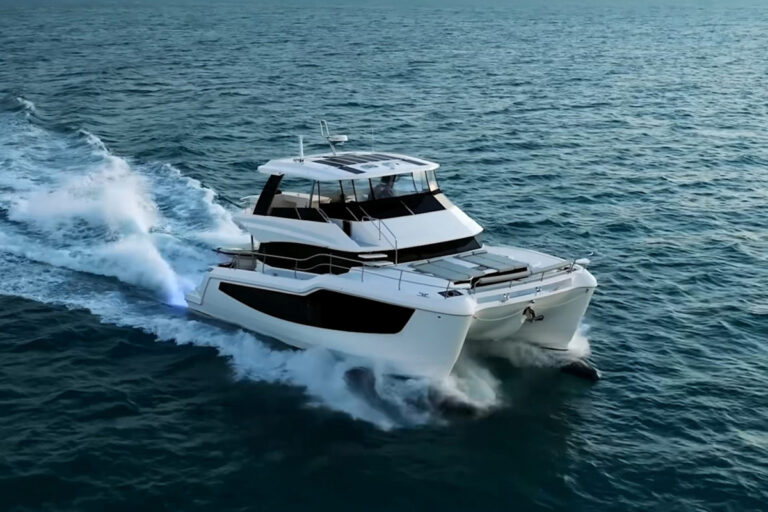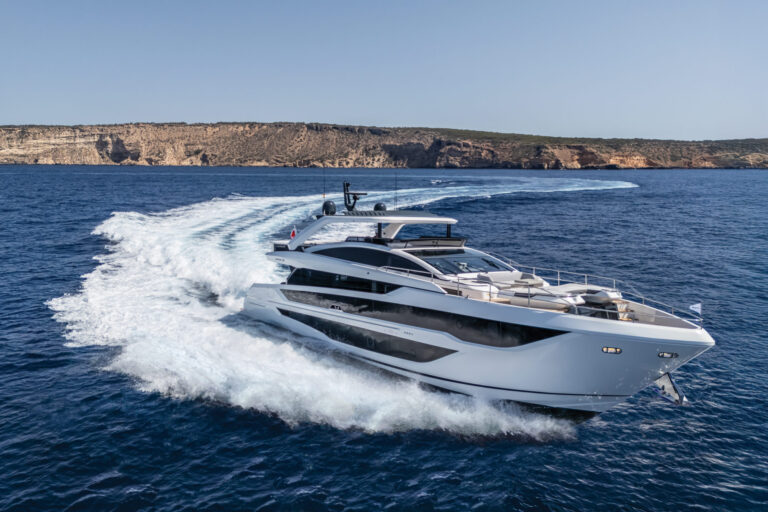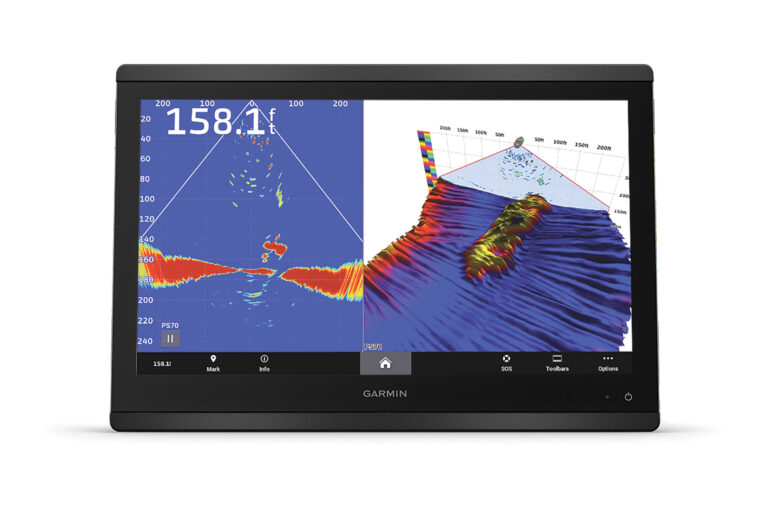Half a millennium ago, Francis Bacon said, “Histories make men wise. If that is true, there must be a heap of wisdom at Burger Boat Company. The Wisconsin yard launched its first vessel 139 years ago, when Lincoln was president. The early decades saw scores of schooners, steamships and military vessels launched into Lake Michigan, and the past 50 years have seen a shift to aluminum motoryachts.
One of Burger’s latest creations is Serenity. At 105 feet overall, she is not the longest Burger afloat. By intent, she is also not the tallest. Her owners, Mr. and Mrs. Gordon Stewart, wanted a design that would allow them to comfortably explore as wide a range of cruising grounds as possible, and many of the boat’s features were created to fulfill that desire.
Serenity is a raised pilothouse configuration with a folding mast that permits an air draft of just 19 feet. This will allow the Stewarts to make summer trips to the Great Lakes via the central river route (and under fixed bridges in Chicago), instead of traveling the big northeastern loop from the East Coast each season. The folding mast is an updated solution to the same challenge Burger faced three decades ago, with the 125-foot Arara III. Modern electronics at the time brought new obstacles, and Arara had a modest mast that could be lowered by hand. Serenity, with her huge array of domes and antennae, required a double-folding mechanism with hydraulic actuation.
To broaden the couple’s available cruising grounds even further, Burger’s in-house naval architect, Don O’Keeffe, carved propeller tunnels into the hull bottom. Draft is 5 feet, 3 inches, shallow enough for use in the Bahamas but deep enough for good rough-weather maneuvering.
“Carving is an apt description of O’Keeffe’s style. He clings to classical design methods by whittling out a half-model for many of Burger’s hulls.
“Model making plays a large part in the development of new designs, O’Keeffe said. “I usually build a scaled half model and take the lines directly from this sculpture to create the full-size form.
While model making may seem quaintly old-fashioned to some, consider that the latest in cutting-edge computer design technology, 3-D modeling, is simply an electronic version of the same process. The computerized process, while faster, is not nearly as relaxing and fails to give the designer a literal “feel for the hull shape.
O’Keeffe applauds the Stewarts for their involvement in the design and for the decisions they made along the way, including the choice to go bigger.
“He is interested in quite extensive cruising, O’Keeffe said of Gordon Stewart, “so he did need more room. The boat grew in size quite a bit from the initial concept.
While Serenity is not the longest, widest, deepest or tallest Burger, she is arguably one of the most refined. The Stewarts were very involved in her interior design, which is warm and traditional with French overtones, elegant yet comfortably familiar. Clever woodwork detailing gives the impression of freestanding furniture, as if the owners had brought aboard favorite family heirlooms.
The joinery is composed of newly constructed built-ins fitted to the scale of the yacht. Outstanding examples of the concept are in the berth-side tables and bow-front lavatory cabinets; the unit in the VIP bath is open at the bottom, with delicate gold-leafed legs resembling those of an antique side table. Many of the bulkheads and larger pieces are mahogany detailed with raised panels and finished in a rich, medium tone.
As attractive and comfortable as the interior is, it comes at some cost in performance. O’Keeffe is satisfied with Serenity‘s top speed in the 20-knot range, pointing out that she is no lightweight. In addition to the interior’s weight, there is a considerable amount of rugged, first-class equipment in the engineroom, including the redundancy appropriate in a yacht used for extensive cruising.
“I’m seeing a trend where people aren’t that excited about speed anymore, O’Keeffe said. “They just prefer to have what they want onboard and be done with it.
To carry the weight at moderate speed, O’Keeffe designed a variation of earlier Burger semi-displacement hulls. Serenity has straight buttock lines aft and a moderate keel for tracking in following seas. Placing the engineroom aft reduced the amount of buoyancy needed forward, allowing the hull to have a shallow forefoot and fine entry with limited bow flare. The combination pays off. With little fuss, Serenity slices cleanly through the water, keeping her bow wave to a minimum.
The Stewarts, knowing they would be aboard for extended periods, allocated adequate space for themselves and their crew. The master stateroom is a full-beam space near amidships. The couple opted for a single bath and his-and-her closets, rather than the reverse found on many newer yachts. The choice is partially a matter of personal preference, of course, but also addresses the need for extra locker space when cruising.
Guests are accommodated in two large staterooms, one with twin berths and the other with a queen, both adjacent to the engineroom. A third guest cabin, smaller than the two main guest staterooms, is to port with upper and lower berths. All guest staterooms have private baths.
Two crew’s cabins are forward, one with upper and lower berths. The captain’s cabin has an island double berth on centerline, much like the master cabin on a smaller yacht. There are two shared heads, one with a shower. The flexible arrangement will work well as long as none of the crew has issues with privacy.
A small lounge is belowdecks for the crew, but my bet is they will mingle in the dinette in the main deck’s country kitchen whenever possible. It is an airy, beautiful spot with a great view. That and a large central island will make the space an informal gathering spot for guests, as well. Two small tables, rather than one large one, allow easy access to all parts of the large, U-shape settee when a crowd is seated.
Abaft the raised pilothouse, the dining area and saloon share a single space. Both are defined by circular-paneled overheads and Aubusson-style carpeting. The overheads were Mr. Stewart’s focus; the carpets, Mrs. Stewart’s. The afterdeck has a settee, a table and an engineroom access hatch. The hatch provides a second means of escape from the machinery space in case of emergency, and it is a safer entry point than the transom door in heavy weather.
On the upper deck, a small helm is on centerline, adjacent to a stair from the pilothouse. A tender is stowed athwartships at the after end of the deck. Most of the space, however, is devoted to guest relaxation. Food prep areas flank the mast base, and dining areas are abaft. The high point of the deck, quite literally, is the raised whirlpool spa. With sunpads on either side, the spa will surely be a favorite spot. Another great place to watch the world go by is the riding seat on the foredeck, a traditional touch too often omitted on modern yachts.
Modern features worthy of consideration, however, are Serenity‘s five large, flat-screen monitors for television and movie viewing. Yachts are not inexpensive by nature, but such monitors seem especially costly when compared with traditional TVs. Installed cost is another matter because the boxes needed for traditional built-in units take up a lot of pricey real estate. Flat-screen units, because of the reduced volumetric space they occupy, can actually be a better value overall.
Holding on to the past when sensible and embracing the new when it offers advantages yields the best of all possible worlds. The Stewarts clearly understand this concept, one whose application has helped Burger remain competitive for so many years.
Contact: Burger Boat Company, (920) 684-1600; fax (920) 684-6555;








